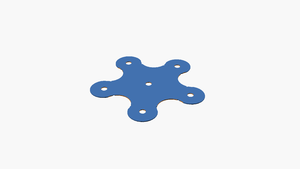Geodesic domes: Difference between revisions
From
No edit summary |
No edit summary |
||
| Line 1: | Line 1: | ||
{{Projects infobox | {{Projects infobox | ||
|image | |image = Plate-griddome.png | ||
|designer | |designer = [[User:Tim|Timothy Schmidt]] | ||
|date | |date = 2012 | ||
|vitamins = | |vitamins = | ||
|materials = | |materials = | ||
|transformations = | |transformations = | ||
|lifecycles = | |lifecycles = | ||
|tools | |tools = [[Wrenches]] | ||
|parts | |parts = [[Plates]], [[Frames]], [[Nuts]], [[Bolts]], [[End caps]] | ||
|techniques | |techniques = [[Bolting]] | ||
|stl | |stl = | ||
|git | |git = | ||
}} | }} | ||
Revision as of 12:14, 26 May 2021
Project: Geodesic domes
| Tools: | Wrenches |
|---|---|
| Parts: | Plates, Frames, Nuts, Bolts, End caps |
| Techniques: | Bolting |
Introduction
A geodesic dome is a hemispherical thin-shell structure based on a geodesic polyhedron. The triangular elements of the dome are structurally rigid and distribute the structural stress throughout the structure, making geodesic domes able to withstand very heavy loads for their size. Its "omnitriangulated" surface provides an inherently stable structure, and a sphere encloses the greatest volume for the least surface area.
Challenges
Creating joints at angles other than 90 degrees can pose a significant challenge.
Approaches
Geodesic dome brackets were designed, cut, and bent into shape upon installation.
-
Geodesic dome plate
-
Grid dome Maker Faire Detroit 2012
-
Improvised dome joint
-
Griddome Maker Faire San Francisco 2013




